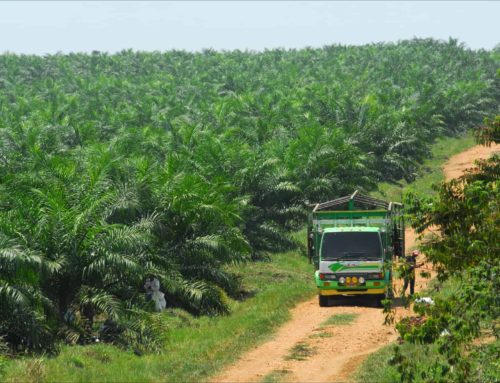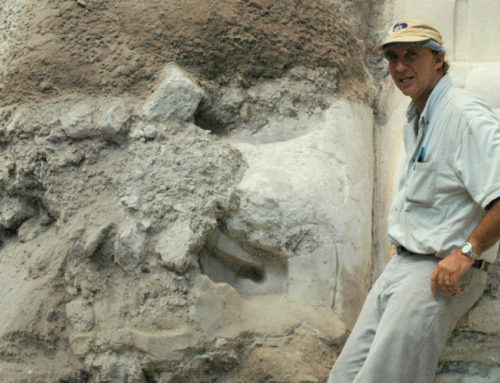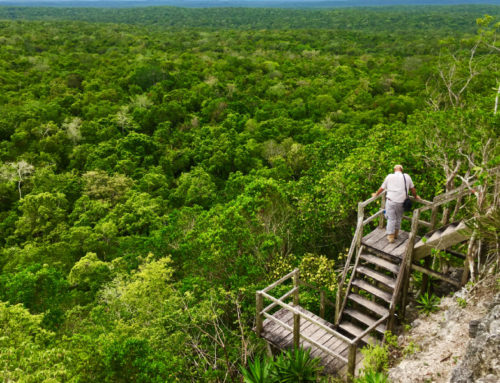Flores, Guatemala – Maya Biosphere Watch recognizes that legislation S.3131 introduced into the U.S. Congress by Senators Jim Inhofe (R-Oklahoma), Tom Udall (D-New Mexico), Jim Risch (R-Idaho), and archaeologist Richard D. Hansen is an intrusion in Guatemala’s current conservation policies and against the land rights of the Guatemalan people. The bill attempts to create a U.S. law that would drastically alter current land management systems in the Maya Biosphere Reserve (MBR) in Guatemala and, eventually, that of the Calakmul Biosphere Reserve (CBR) in Mexico. Dr. Hansen, and his team, work under the Foundation for Anthropological Research and Environmental Studies (FARES), and their proposal is considered a “Green Land Grab” that goes against the wishes of the majority of people and conservation organizations in Petén, Guatemala.
A “Green Land Grab”, also known as “Green Grabbing” is a process of using environmental green agendas as justification of controlling or taking land away from the people who own or live off the said land.
The proposed U.S. legislation (S.3131), being called “The Mirador-Calakmul Basin Maya Security & Conservation Partnership Act” was made public on Dec 27, 2019 in a press release by Maya Conservation Partnership (West Palm Beach, Florida), in support of Hansen’s on going fundraising for his Mirador Basin initiative.
The proposal seeks 60 million dollars in funding from the U.S. Government suggesting that the land is not protected and needs protection to “strengthen governance and law enforcement” in the MBR. An additional 60 million dollars is also being sought as a loan from The Central American Development Bank (BCIE) for infrastructure, for a total of 120 million dollars.
However, currently the MBR is under the jurisdiction of the Guatemalan government conservation laws and institutions, managed and led by Guatemala’s National Council of Protected Areas (CONAP), and co-managed by other institutions that include the Centro de Estudios Conservacionistas of the Universidad de San Carlos de Guatemala (CECON-USAC), Fundación Defensores de la Naturaleza, and the Ministry of Culture and Sports. It is also protected by conservation organizations, and some areas are in-part managed by the Association of Forestry Communities of Petén (ACOFOP) under 25-year agreements for sustainable forestry activities, certified by the Forest Stewardship Council (FSC). In México, the CBR is under the Federal Law of Monuments and Archaeological Zones and the CONANP (Comisión Nacional de Áreas Naturales Protegidas).
“In Guatemala there are institutions that are responsible for the management of national parks, cultural monuments and other categories of protected areas,” says Sofia Paredes Maury, current Board-member of the Asociación de Reservas Naturales Privadas de Guatemala and former Sub-director of the Institute of Anthropology and History (IDAEH), with a chair in CONAP. “How is it possible to pass a law, in a foreign country, for a Guatemalan National Park to be managed as a private property? And who will receive such funding? Do they know that Parque Nacional Mirador Río Azul has a Category 1 management by Law? Are American taxpayers aware where their taxes are going?
“The area mentioned in the proposal has been sheltered from wildfires, and looting has notably been reduced, thanks to the communities that have forestry management concessions. Guatemala has a law for Protected Areas and a law for Cultural Heritage, that seem not to be taken into account in this proposal.
“Previous foreign interventions have left a bitter taste in Guatemalan memory and have caused a justified mistrust among the local population.”
The news released by the Mirador Conservation Partnership is misleading in not providing details in regards to the economic agenda by Hansen and his team that includes allowing private businesses to function in the MBR. This plan includes the construction of hotels and a train which will allow for increased tourism in the delicate ecosystem of the MBR in the name of “a sustainable tourism model” for economic development.
The press release states, “Law S.3131 will promote with priority the continuity of archaeological research, multidisciplinary environmental studies of tropical forests and, in addition, the promotion of a sustainable tourism model to provide economic and development opportunities for Guatemala, the Petén and the local communities surrounding the Basin.”
However, to date, archaeological research in Péten has not been hindered in anyway, nor have conservation efforts. In fact, The Maya Biosphere Reserve has seen a net growth in forest thanks to forestry concessions. Looting is also at an all-time low, and threats of drug trafficking, which mostly takes place in the area of Laguna del Tigre, far from the Mirador area, are contained by the Guatemalan military.
Furthermore, this “Green Land Grab” would take management away from forestry concessions, the current model for conservation that has been operating successfully since 1995, employing over 26,000 Peteneros and indigenous peoples, in favor of private investors and companies. Recognized globally, these Guatemalan forestry concessions have received awards from the United Nations Development Program and the United Nations Environmental Program and have provided a management model worldwide.
The achievements of forestry concessions have recently been recognized by the National Council of Protected Areas (CONAP) and the Government of Guatemala with an unanimously approved contract renewal to the Cooperativa Carmelita for the next 25 years.
“Carmelita is a century-old forest community in Petén that manages an area in concession of 53,797 hectares in the Multiple Uses Zone (ZUM) of the Maya Biosphere Reserve. Through the community forest model Carmelita has been using various forest products such as xate palm, pepper, gum, beekeeping and mahogany since 1997, offering tourist services to the archaeological site El Mirador.
“Harvesting activities create jobs and contribute to social welfare through investment in education and health services for more than 400 people in a community of about 950. In addition, Cooperativa Carmelita invests 500,000 quetzals per year in forest conservation and fire prevention through control and monitoring.
“The community work of the concessions in Petén is responsible for the conservation and rescue of several species of endangered flora and fauna, as well as the reduction of the deforestation rate to 0.4% and the declaration of a fire-free zone in the concession areas.” – ACOFOP (https://acofop.org/victoria-historica-para-el-modelo-forestal-comunitario/)
Since 2002, archaeologist Richard Hansen has openly fought against forestry concessions and pursued a claim for 3000 KM2 of the MBR, succeeding through Guatemalan Presidential Decree 129-2002 which declared the area The Mirador Basin Special Archaeological Zone superimposing upon preexisting management units including forestry concessions. After a huge three-year battle and protest from the local residents and concessions workers the The Mirador Basin Special Archaeological Zone was rescinded in 2005, and the forest concession model was reinforced.
“We as the People of Carmelita have been in the territory for more than 100 years, taking care of the forest and living off its natural resources for 3 generations already. We believe that the area must be used for tourism-related activities and that there must be alliances and investments, of course; the state and private companies are allies for development. What we find hard to understand is that this plan comes from someone who does not take into account either the government or the communities!” says Carlos Alberto Crasborn, legal representative of Cooperativa Carmelita.
“What’s surprising is that this plan comes from an archaeologist who thinks he owns the area in which he proposes preservation. We believe he has done a good job, but it’s not only through money that a natural area is taken care of. If the local communities are not taken into consideration, the problems of the region will become more profound.”
Hansen’s agenda now flows over the border into Mexico and includes the Calakmul archaeological zone, as was announced as a partnership on the Maya Conservation Partnership website.
Adriana Velázquez Morlet, Director of INAH (National Institute of Anthropology and History) in Campeche, Mexico, states:
“Given the heated debates that have been reported in various media outlets regarding an alleged archaeological and tourism project funded by the United States Government and directed by Dr. Richard Hansen, which would include the area of the El Mirador, in the north of the Guatemalan Peten jungle, and eventually a sector of the Mexican Peten tropical forest in Campeche, specifically the site of Calakmul, I would like to make some clarifications as head of INAH in Campeche:
- INAH has no knowledge of any initiative presented by the team of the Dr. Hansen that involves any archaeological sites in southern Campeche, Mexico.
- Therefore, the Archaeology Council has not approved any project in this regard and there is no intention of linking this initiative with the “Tren Maya” project, which no longer includes a branch line to the archaeological zone of Calakmul.
- It should not be forgotten that Calakmul is a Mixed Property recognized by UNESCO as a World Heritage Site, so it is subject to special monitoring and supervision by INAH and CONANP (National Commission of Natural Protected Areas).
- Any issues involving the Calakmul region in Mexico are addressed within the exclusive framework of Mexican laws, so we will be very attentive to guarantee the application of the Federal Law on Monuments and Archaeological Areas in Calakmul and anywhere else in the State of Campeche.”
Critics state that the concept of the Mirador-Calakmul Basin is based on a false geographical description of the area being a Basin. This has been proven false by academics and geologists countless of times, and yet Hansen and his team continue to push the Basin claim. Hansen often uses an infrared image to claim his Basin theory to non-academics.
Dr. David Hixson, a specialist in multispectral remote sensing in the Maya area, says “Infrared imagery will not indicate a basin. It indicates vigorous photosynthetic growth.” He suggests that, “SRTM (Shuttle Radar Topography Mission) is a more appropriate tool.”
In summary, Maya Biosphere Watch wishes to highlight that the initiative created by Hansen for the US Congress is not in partnership with the Government of Guatemala, nor with CONAP, nor with the local communities. The initiative does not have the support of community organizations such as ACOFOP. It also does not have the support of the US State Department – USAID supports forestry concessions. Furthermore, the so called “Mirador-Calakmul Basin” is nothing more than a fabrication used to support an agenda to take control away from local cooperatives and place it in the hands of investors and developers, a true “Green Land Grab”. Finally, there is no agreement between Guatemala and Mexico for the creation of a “Mirador-Calakmul Basin” protected area. The proposal presented into the United States congress clashes directly with Guatemala’s current conservation laws that grant sustainable management rights to cooperatives of local residents.
***
ORGANIZATIONS PROTECTING THE MAYA BIOSPHERE RESERVE (Guatemala)
The Guatemalan government institutions that are currently protecting the Maya Biosphere Reserve, and are part of the National Counsel for Protected Areas, include:
- Secretaría ejecutiva del CONAP (executive secretary of the Consejo Nacional de Áreas Protegidas)
- MARN (formerly CONAMA) (Ministerio de Ambiente y Recursos Naturales)
- CECON / USAC (Centro de Estudios Conservacionistas de la Universidad de San Carlos de Guatemala)
- IDAEH/ DGPCyN (Instituto de Antropología e Historia/ Dirección General del Patrimonio Cultural y Natural)
- ANAM (Asociación Nacional de Municipalidades)
- INGUAT (Instituto Guatemalteco de Turismo)
- A delegate of an environmental organization registered in CONAP
Conservation organizations include:
- WCS (Wildlife Conservation Society)
- Rainforest Alliance
- Fundación Defensores de la Naturaleza
Forestry Concessions and conservation groups include:
- ACOFOP (Asociación de Comunidades Forestales de Petén)
- COOPERATIVA CARMELITA (SAN ANDRÉS, PETÉN)
- ORGANIZACIÓN MANEJO Y CONSERVACIÓN (OMYC) (UAXACTÚN, FLORES, PETÉN)
- SOCIEDAD CIVIL IMPULSORES SUCHITECOS (MELCHOR DE MENCOS, PETÉN
- SOCIEDAD CIVIL SAN ANDRÉS (AFISAP) (SAN ANDRÉS, PETÉN)
- SOCIEDAD CIVIL CUSTODIOS DE LA SELVA (MELCHOR DE MENCOS, PETÉN)
- SOCIEDAD CIVIL ÁRBOL VERDE (IXLÚ, FLORES, PETÉN)
- RED FORESTANDO CHACHAKLUM (SAN FRANCISCO, PETÉN)
- SOCIEDAD CIVIL SELVA MAYA DEL NORTE (MELCHOR DE MENCOS, PETÉN)
- SOCIEDAD CIVIL EL ESFUERZO (MELCHOR DE MENCOS, PETÉN)
- ASOCIACIÓN FORESTAL INTEGRAL CRUCE A LA COLORADA (SAN ÁNDRES, PETÉN)
- COOPERATIVA LA TÉCNICA (MELCHOR DE MENCOS, PETÉN)
- COOPERATIVA LA LUCHA (LAS CRUCES, PETÉN)
- COOPERATIVA LOS LAURELES (LAS CRUCES, PETÉN)
- SOCIEDAD CIVIL LABORANTES DEL BOSQUE (MELCHOR DE MENCOS, PETÉN)
- SOCIEDAD CIVIL AMIGOS DEL BOSQUE (MELCHOR DE MENCOS, PETÉN)
- COOPERATIVA UNIÓN MAYA ITZÁ ( LAS CRUCES, PETÉN )
- ASOCIACIÓN MURALLA DE LEÓN (AMUL) (FLORES, PETÉN)
- ASOCIACIÓN BIO-ITZA (SAN JOSÉ, PETÉN)
- ASOCIACIÓN CIVIL FRENTE PETENERO (SANTA ELENA, PETÉN)





